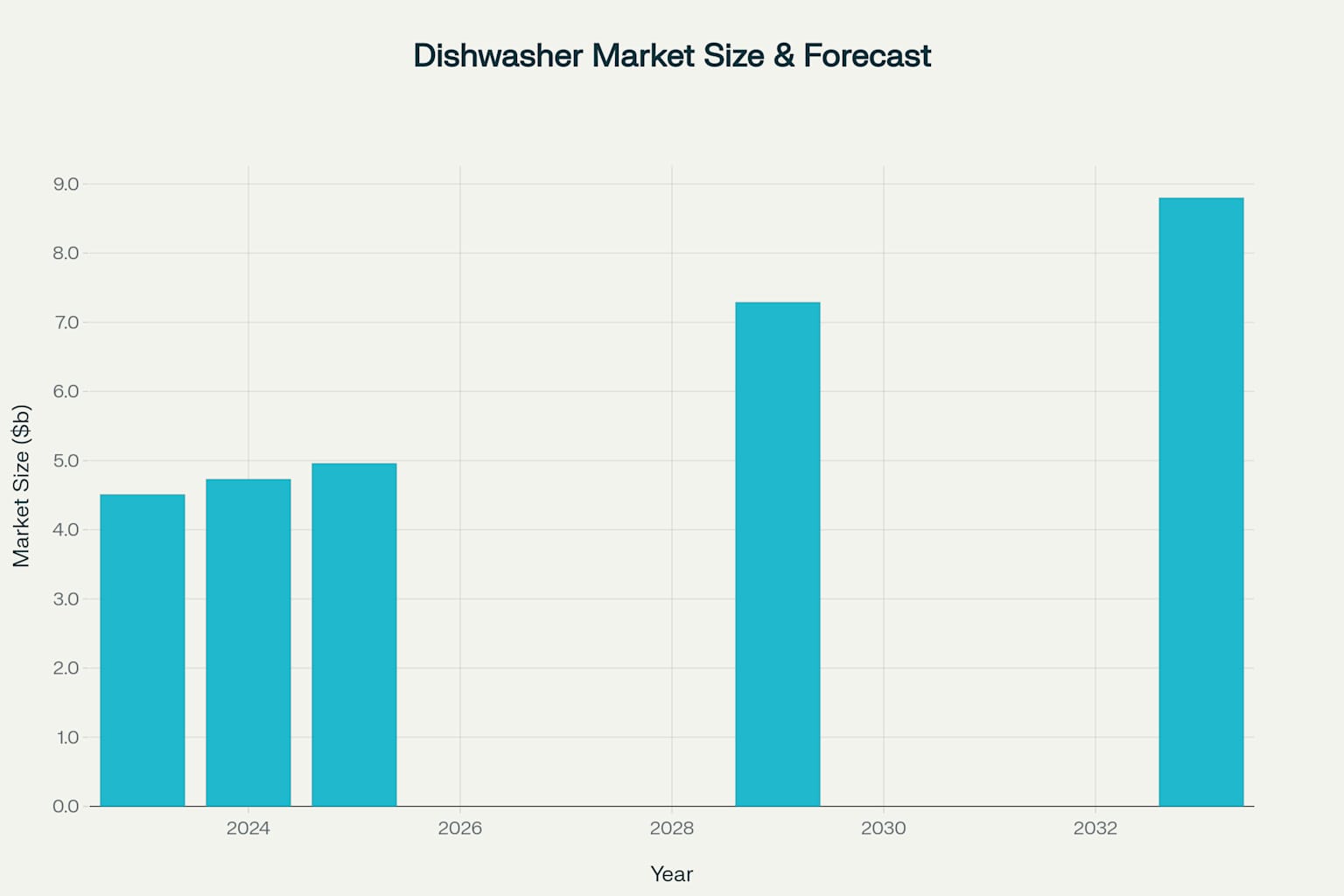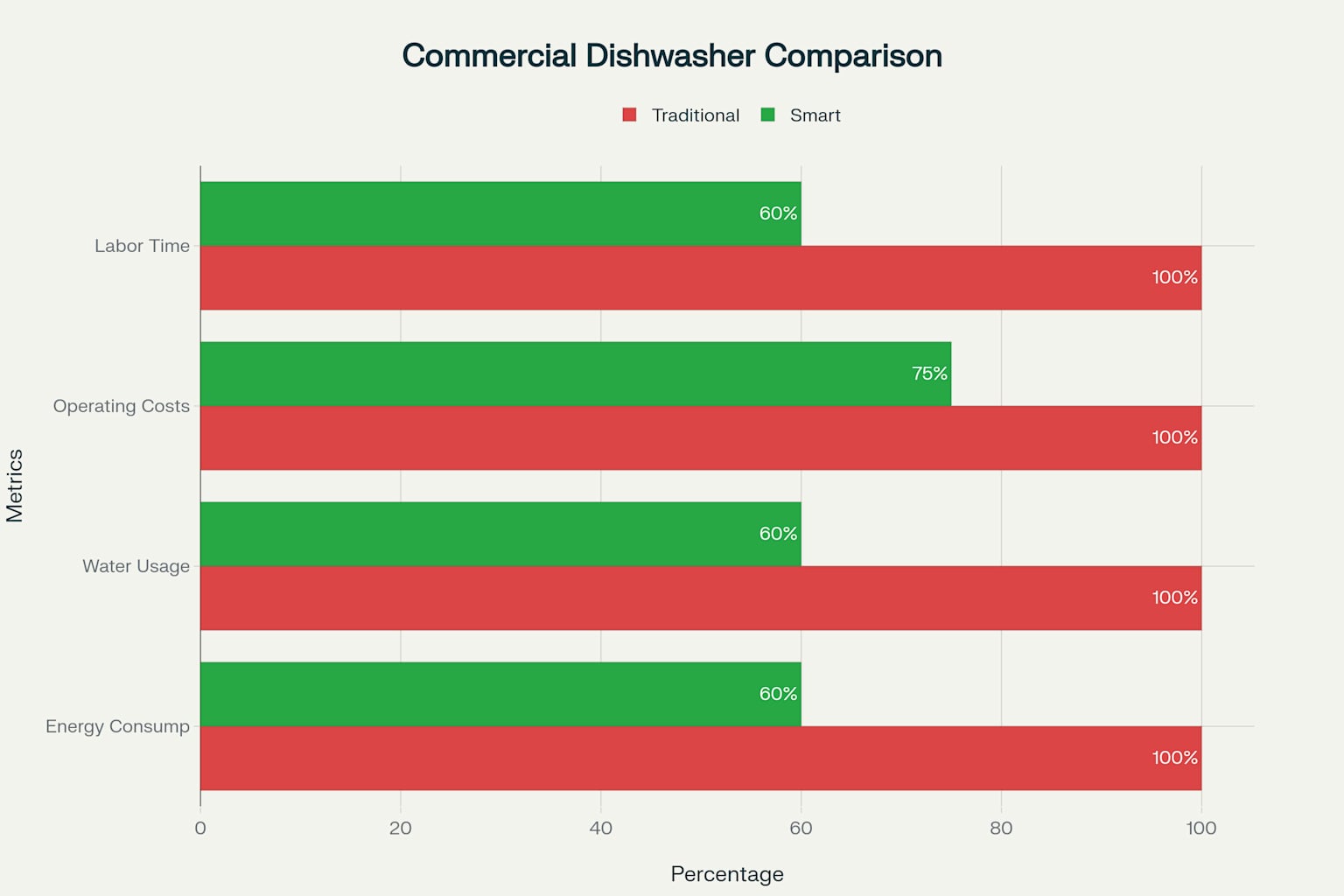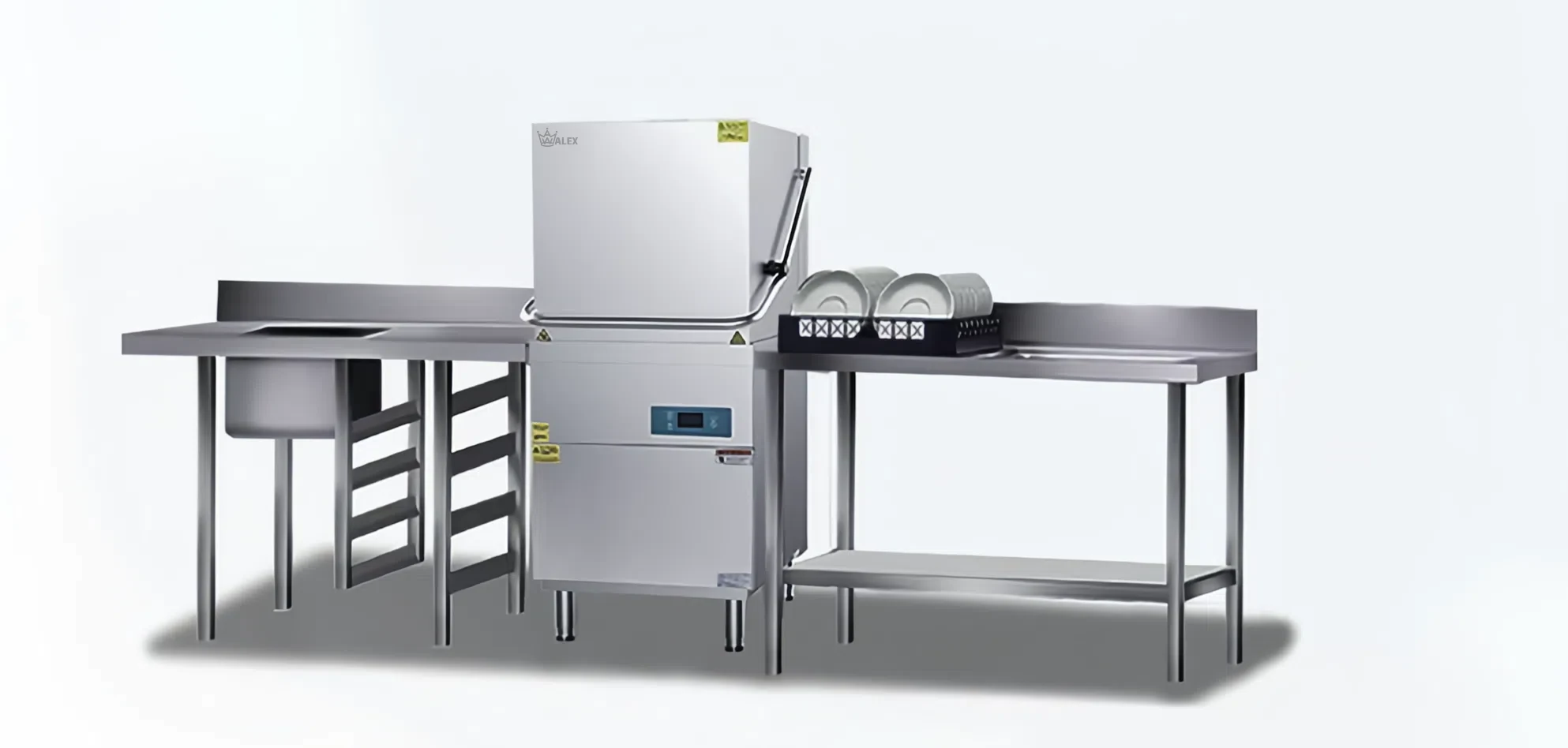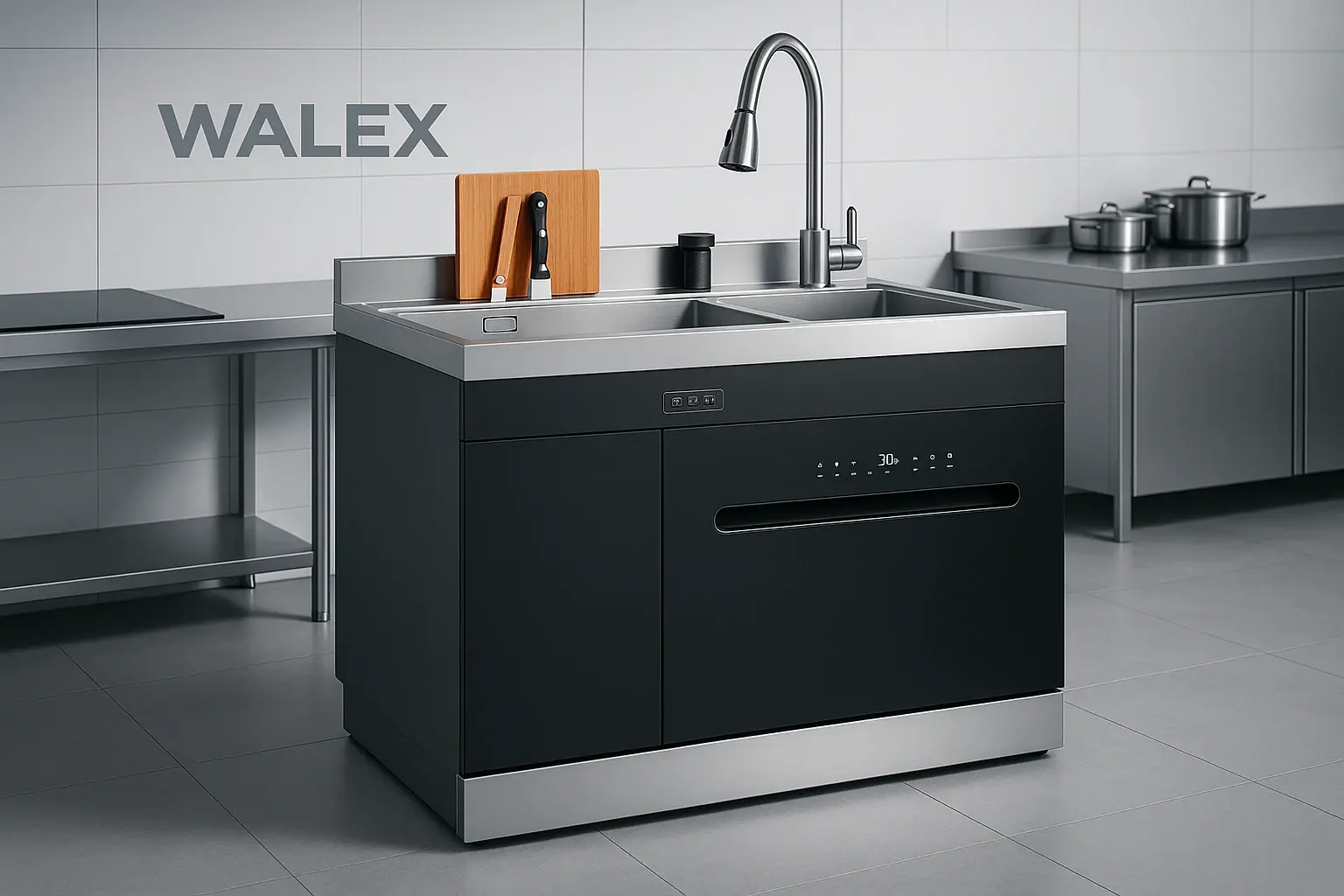The commercial dishwasher industry is experiencing a transformative period in 2025, driven by technological innovation, sustainability demands, and operational efficiency requirements. This comprehensive analysis examines the current state of commercial dishwashers featuring intelligent functionality, simplified operation, and energy-efficient design, with particular focus on high-capacity washing requirements and wireless connectivity capabilities.
Executive Summary
The global commercial dishwasher market demonstrates robust growth trajectory, reflecting increasing demand for automated, efficient cleaning solutions across hospitality, healthcare, and foodservice sectors. Modern commercial dishwashers in 2025 represent a convergence of smart technology, environmental consciousness, and operational excellence, offering unprecedented levels of efficiency and connectivity.

Global Commercial Dishwasher Market Size and Forecast (2023-2033)
The market expansion from $4.51 billion in 2023 to a projected $8.8 billion by 2033 underscores the critical role these systems play in modern commercial operations. This growth is primarily driven by urbanization trends, rising hygiene standards, and the increasing adoption of smart kitchen technologies.
Smart Features and Connectivity Revolution
Intelligent Operation Systems
Commercial dishwashers in 2025 have evolved far beyond simple wash-and-rinse cycles. Today’s intelligent systems incorporate advanced sensor technology that automatically adjusts wash parameters based on soil detection, load size, and dish types. These systems feature intuitive touchscreen interfaces with color-coded LED indicators that provide real-time status updates, making operation accessible to staff regardless of technical background.
The implementation of smart sensors enables automatic cycle optimization, reducing both water consumption and energy usage while maintaining superior cleaning performance. Machine learning algorithms continuously adapt to usage patterns, optimizing performance for specific operational environments and load characteristics.
Bluetooth and IoT Connectivity
Wireless connectivity has become a standard feature in premium commercial dishwashers, with Bluetooth and Wi-Fi capabilities enabling seamless integration with kitchen management systems. This connectivity allows managers to monitor machine performance remotely, receive maintenance alerts, and track operational metrics through dedicated mobile applications.
The IoT integration extends beyond basic monitoring to include predictive maintenance capabilities, inventory management for chemicals and supplies, and energy usage optimization. Remote diagnostics enable service technicians to identify and resolve issues before they impact operations, significantly reducing downtime.
User Interface Innovation
Modern commercial dishwashers feature simplified operation through advanced human-machine interfaces. Ergonomic touch displays with multilingual support eliminate language barriers in diverse workplace environments. Visual progress indicators and programmable shortcuts enable quick access to frequently used cycles, reducing training requirements and operational complexity.
Energy Efficiency and Steam Recovery Technology
Advanced Heat Recovery Systems
The most significant advancement in commercial dishwasher technology is the integration of sophisticated steam recovery units. These systems capture waste heat from the washing and rinsing cycles, using it to preheat incoming water and reduce overall energy consumption. The technology represents a paradigm shift from traditional linear energy consumption to circular heat utilization.

Traditional vs Smart Commercial Dishwashers: Efficiency Comparison
Steam recovery systems in 2025 models achieve remarkable efficiency gains, with some units reducing energy consumption by up to 40% compared to conventional systems. The recovered heat is utilized through advanced heat exchangers that maintain optimal washing temperatures while minimizing energy input requirements.
Water Conservation Innovation
Modern commercial dishwashers employ closed-loop water systems that significantly reduce consumption through intelligent recycling and filtration. Advanced filtration systems enable multiple reuse cycles of wash water, while precision dosing systems ensure optimal chemical utilization without waste.
The integration of reverse osmosis technology in premium models eliminates the need for manual water treatment, producing spot-free results while reducing chemical dependency. These systems can achieve water savings of up to 40% compared to traditional models while maintaining superior cleaning performance.
Environmental Impact Reduction
Energy-efficient designs extend beyond immediate operational savings to substantial environmental benefits. The combination of heat recovery, water conservation, and optimized chemical usage reduces the overall carbon footprint of commercial dishwashing operations. Many 2025 models achieve Energy Star certification, with some exceeding efficiency standards by significant margins.
High-Capacity Solutions for Commercial Operations
Scalable Performance Architecture
Commercial dishwashers designed for high-capacity operations feature modular architectures that can be configured to meet specific volume requirements. Conveyor systems with variable speeds accommodate different dish types and soil levels, optimizing throughput without compromising cleaning quality.
High-capacity models incorporate multiple washing zones with independent temperature and chemical controls, enabling simultaneous processing of different dish categories. This parallel processing capability significantly increases overall throughput while maintaining specialized treatment for delicate items like glassware.
Automated Loading and Unloading Systems
Advanced high-capacity units feature automated rack handling systems that reduce manual labor requirements and improve operational efficiency. Robotic loading arms and conveyor integration enable continuous operation with minimal human intervention, addressing labor shortage challenges while improving consistency.
The automation extends to sorting and pre-treatment systems that automatically detect dish types and apply appropriate cleaning protocols. This intelligence reduces the skill requirements for operation while ensuring optimal cleaning results across diverse dishware categories.
Rapid Cycle Technology
High-capacity commercial dishwashers achieve exceptional throughput through rapid cycle technology that maintains thorough cleaning while reducing processing time. Advanced spray arm designs with precision-engineered nozzle patterns ensure complete coverage in abbreviated timeframes.
The implementation of flash-drying technology enables immediate availability of cleaned items, eliminating bottlenecks in high-volume operations. Combined with intelligent staging systems, these innovations enable seamless integration with fast-paced commercial kitchen operations.
Practical Implementation and User Experience
Installation and Integration Benefits
Modern commercial dishwashers are designed for simplified installation with reduced infrastructure requirements. Ventless technology eliminates the need for complex ventilation systems, enabling flexible placement within existing kitchen layouts. This flexibility is particularly valuable in urban environments where space constraints limit traditional installation options.
The plug-and-play connectivity of smart systems enables rapid integration with existing kitchen management platforms. Standardized communication protocols ensure compatibility across different equipment manufacturers, facilitating seamless ecosystem integration.
Operational Efficiency Gains
Real-world implementation of smart commercial dishwashers demonstrates significant operational improvements across multiple metrics. Labor time reductions of 40% are commonly achieved through automation and simplified operation, while energy costs decrease by comparable percentages through efficiency innovations.
The consistency of automated systems eliminates variability in cleaning results, ensuring compliance with health regulations while reducing waste from rewashing. This reliability is particularly valuable in high-stakes environments such as healthcare facilities and fine dining establishments.
Maintenance and Lifecycle Management
Predictive maintenance capabilities significantly reduce unplanned downtime through early identification of potential issues. Automated diagnostic systems provide detailed maintenance schedules and consumable replacement reminders, optimizing equipment lifecycle management.
The modular design of modern systems enables component-level servicing, reducing maintenance costs and minimizing operational disruption. Remote monitoring capabilities enable proactive service scheduling during off-peak hours, further optimizing operational continuity.
Industry Applications and Market Adoption
Healthcare and Institutional Sectors
Healthcare facilities represent a critical market segment for advanced commercial dishwashers, with stringent hygiene requirements driving adoption of smart systems with comprehensive monitoring capabilities. The ability to document cleaning cycles and temperatures provides essential compliance documentation for regulatory requirements.
Educational institutions and corporate cafeterias benefit from the simplified operation and reduced labor requirements of intelligent systems. The scalability of modern units enables efficient handling of peak demand periods while maintaining cost-effective operation during lower-volume periods.
Hospitality and Restaurant Industries
The restaurant industry’s adoption of smart dishwashing technology is accelerated by labor challenges and increasing quality expectations. The combination of reduced training requirements and improved consistency addresses key operational challenges while supporting brand reputation management.
Hotel operations particularly benefit from the flexible capacity and energy efficiency of modern systems. The ability to optimize operation based on occupancy patterns and event schedules provides significant cost advantages while maintaining service quality standards.
Emerging Market Segments
Cloud kitchens and delivery-focused food operations represent growing market segments for compact, high-efficiency dishwashing solutions. These operations require maximum efficiency in minimal space, driving demand for innovative designs that optimize throughput while minimizing footprint.
Food processing and manufacturing facilities increasingly adopt commercial-grade dishwashing systems for equipment cleaning applications. The robust construction and chemical compatibility of modern units enable expansion beyond traditional foodservice applications.
Future Outlook and Technology Trends
Artificial Intelligence Integration
The next evolution in commercial dishwasher technology involves deeper artificial intelligence integration, enabling autonomous optimization of cleaning cycles based on real-time analysis of soil conditions and dish types. Machine learning algorithms will continuously refine performance parameters, adapting to specific operational environments and usage patterns.
AI-powered systems will extend to predictive analytics for inventory management, automatically ordering consumables based on usage patterns and operational forecasts. This intelligence will eliminate manual monitoring requirements while ensuring continuous operation.
Sustainability Innovation
Environmental consciousness continues to drive innovation in energy recovery and water conservation technologies. Advanced materials and manufacturing processes will further reduce the environmental impact of production while enhancing operational efficiency throughout the equipment lifecycle.
The integration of renewable energy systems and smart grid connectivity will enable commercial dishwashers to optimize operation based on energy availability and pricing, further reducing operational costs and environmental impact.
Connectivity and Integration Evolution
The expansion of IoT ecosystems will enable deeper integration between dishwashing systems and comprehensive kitchen management platforms. This connectivity will provide holistic operational insights, enabling optimization across all kitchen systems rather than individual equipment optimization.
Blockchain technology integration may provide comprehensive traceability for cleaning cycles and chemical usage, supporting food safety compliance and quality assurance programs with immutable documentation.
Conclusion
The commercial dishwasher market in 2025 represents a mature technology sector experiencing rapid innovation driven by sustainability requirements, operational efficiency demands, and technological advancement. The convergence of smart features, energy efficiency, and simplified operation creates compelling value propositions for commercial operators across diverse market segments.
The demonstrated benefits of modern systems, including significant reductions in energy consumption, water usage, and labor requirements, provide clear return on investment justification. The integration of wireless connectivity and intelligent operation addresses contemporary operational challenges while positioning organizations for future technological advancement.
As the market continues to evolve, the focus on user experience, environmental responsibility, and operational excellence will drive further innovation. The substantial market growth projections reflect the essential role these systems play in modern commercial operations and the significant opportunities for continued advancement in efficiency and capability.
The transition to smart, connected dishwashing systems represents not merely an equipment upgrade but a fundamental shift toward intelligent, sustainable commercial kitchen operations. Organizations that embrace these technologies will realize immediate operational benefits while positioning themselves for continued advancement in an increasingly competitive marketplace.

